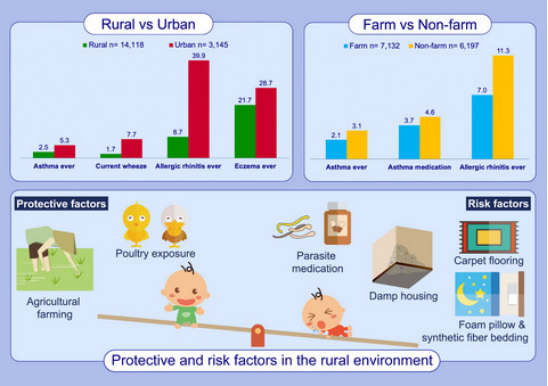Release date:2022-12-16

Allergy
[IF:13.146]
Poultry exposure and environmental protection against asthma in rural childrenDOI: 10.1111/all.15365
Abstract:
Background: Asthma is one of the most common chronic diseases in childhood, and the prevalence has been increasing over the past few decades. One of the most consistent epidemiological findings is that children living in a farming or rural environment are protected from development of asthma and allergies, but the protective factors in rural China are not clear.
Methods: A community-based, cross-sectional epidemiological study was performed in a total of 17,587 children aged 5–8?years, 3435 from Hong Kong (urban) and 14,152 from Conghua (rural county in southern China). Asthma and allergic symptoms as well as environmental exposures were ascertained by using a standardized and validated questionnaire.
Results: The prevalence of current wheeze was significantly lower in rural Conghua than that of urban Hong Kong (1.7% vs. 7.7%, p?<?0.001). A lower rate of asthma ever was also reported in rural children compared with their urban counterparts (2.5% vs. 5.3%, p?<?0.001). After adjusting for confounding factors, exposure to agricultural farming (adjusted odds ratio 0.74, 95% confidence interval: 0.56–0.97) and poultry (0.75, 0.59–0.96) were the most important factors associated with the asthma-protective effect in the rural area. Further propensity score-adjusted analysis indicated that such protection conferred by living in the rural environment was mainly attributable to poultry exposure.
Conclusion: We confirmed that the prevalence of asthma and atopic disorders was significantly lower in rural children when compared with their urban peers. Exposure to poultry and agricultural farming are the most important factors associated with asthma protection in the rural area.
First Author:
Yuhan Xing
Correspondence:
Gary W.K. Wong, Department of Paediatrics, Prince of Wales Hospital, Faculty of Medicine, Chinese University of Hong Kong, Shatin, NT, Hong Kong SAR, China.
2022-12-16 Article
 杭州浙大迪迅生物基因工程有限公司
杭州浙大迪迅生物基因工程有限公司
